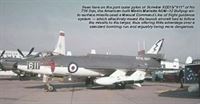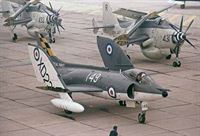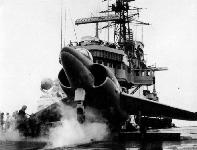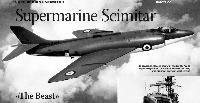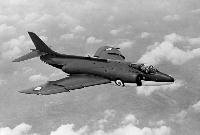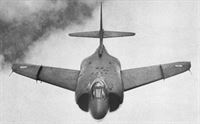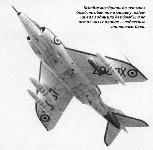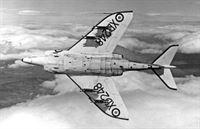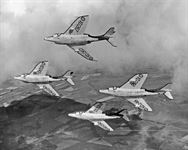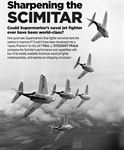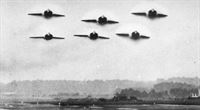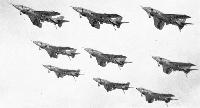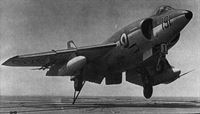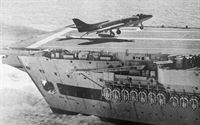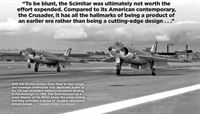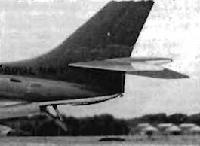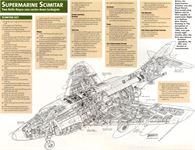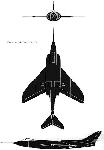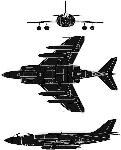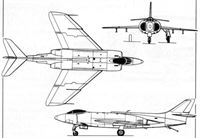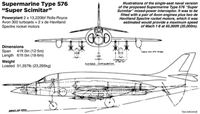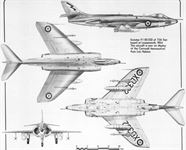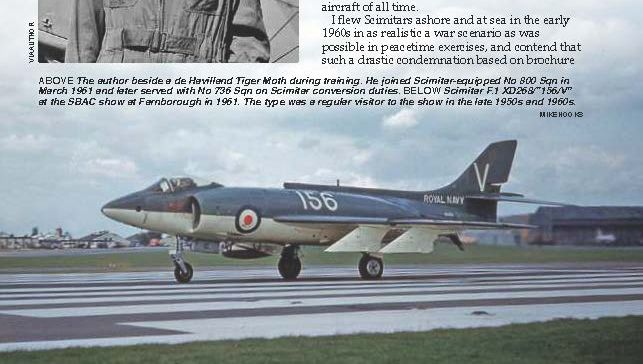
Описание
Страна : Великобритания
Год : 1956
Одноместный палубный многоцелевой самолет
Варианты
- Supermarine - Type 508 / 529 / 525 - 1951 - Великобритания
- Supermarine - Scimitar - 1956 - Великобритания
Supermarine Scimitar
Первый проект компании "Supermarine", разработанный согласно спецификации британских ВМС N.113D, известен как N.113. Первый британский палубный реактивный самолет со стреловидным крылом планировалось принять на вооружение в конце 1940-х годов для использования в качестве трансзвукового перехватчика и истребителя.
Разработка затянулась до начала 1950-х годов. За это время были построены прототипы Type 508 и Type 529 с прямым крылом, на Type 525 использовали уже стреловидное крыло. Финальный Type 544 отличался фюзеляжем, поджатым в районе крыла в соответствии с правилом площадей, крыло оснастили закрылками для снижения минимальной эволютивной скорости.
Первый из трех прототипов Type 544 поднялся в воздух 19 января 1956 года. Поставки серийных Scimitar F.Mk 1 начались в августе 1957 года. Первые самолеты поступили в испытательное звено 700X 803-й эскадрильи. Затем Scimitar получили 800-я, 804-я и 807-я эскадрильи.
При необходимости в носовой части фюзеляжа многоцелевого истребителя можно было установить фотокамеру, а также использовать самолет в качестве заправщика. В ВМС Scimitar использовали как маловысотные истребители-бомбардировщики, способные нести ядерные боеприпасы, высотные перехватчики с УР класса "воздух-воздух", а также в качестве разведчиков.
Хотя Scimitar в качестве носителя тактического ядерного оружия представлял для британского флота исключительную ценность, его начали снимать с вооружения по причине высокой аварийности уже в 1965 году; процесс завершился в 1969 году. На смену Scimitar пришел самолет Blackburn Buccaneer. Всего было построено 76 самолетов Scimitar всех вариантов.
ТАКТИКО-ТЕХНИЧЕСКИЕ ХАРАКТЕРИСТИКИ
Supermarine Scimitar F.Mk 1
Тип: одноместный палубный многоцелевой самолет
Силовая установка: два ТРД Rolls-Royce Avon 202 тягой по 52,63 кН
Летные характеристики: макс. скорость на уровне моря 1143 км/ч; практич. потолок 14 020 м; дальность 2288 км
Масса: пустого 10869 кг; максимальная взлетная 15 513 кг
Размеры: размах крыла 11,33 м; длина 16,87 м; высота 5,28 м; площадь крыла 45,06 м2
Вооружение: четыре 30-мм пушки ADEN и четыре 454-кг бомбы или четыре УР "воздух-поверхность" Bullpup, или четыре УР "воздух-воздух" Sidewinder, или ПТБ, НАР, свободнопадающая тактическая ядерная бомба
- Описание
Фотографии
-
Aeroplane Monthly 1979-03 / C.Andrews - Supermarine Scimitar /Fighters of the fifties/ (22)
Регистрационный номер: WT854 [5] Prototype N113 WT854 which first flew on the 20th January 1956
-
Aviation Historian 38 / P.Stoddard - Sharpening the Scimitar
Регистрационный номер: XD267 [3] Scimitar F.1 XD267, coded “151/R”, in the colours it wore while serving with No 803 Sqn during 1964, including the unit’s distinctive yellow and black chequerboard pattern on the fin. It is fitted with the extra wing-mounted tanks used for “buddy” refuelling duties.
-
Мировая Авиация 213
Регистрационный номер: XD268 [2] Пивная кружка на киле данного Supermarine Scimitar говорит о том, что он приписан к эскадрилье № 800B, а буквенный код "E" свидетельствует о том, что самолет приписан к авианосцу "Игл". Видны подвешенные УР AIM-9 Sidewinder и подвесной контейнер для дозаправки топливом в полете.
-
Aeroplane Monthly 1979-03 / C.Andrews - Supermarine Scimitar /Fighters of the fifties/ (22)
Регистрационный номер: XD321 Scimitar F1 XD321 of 800B Sqn based on HMS Eagle, 1964
-
Aviation Historian 41 / J.Ford - The case for the Scimitar
Регистрационный номер: XD323 Scimitar F.1 XD323/“162/H” of No 804 Sqn (note the unit’s motif of a tiger’s head with a sword in its mouth on the fin) circa 1961 while embarked in HMS Hermes. The inboard pylons carry fuel tanks, while the outboard pylons are fitted with bomb-carriers, each carrying a pair of 25lb practice-bombs.
-
Мировая Авиация 245
Регистрационный номер: XD325 Самолет Scimitar F.Mk 1 с УР "воздух-воздух" AIM-9B и 909-литровыми ПТБ из 804-й эскадрильи авиации ВМС Великобритании. Этот самолет списали после аварийной посадки на авианосец "Арк Ройал" в марте 1966 года.
-
Aviation Historian 41 / J.Ford - The case for the Scimitar
Регистрационный номер: XD268 [2] Scimitar F.1 XD268/“156/V” at the SBAC show at Farnborough in 1961. The type was a regular visitor to the show in the late 1950s and 1960s.
-
Aviation Historian 41 / J.Ford - The case for the Scimitar
Регистрационный номер: XD215 [2] Seen here on the port outer pylon of Scimitar XD215/“611” of No 736 Sqn, the American-built Martin Marietta AGM-12 Bullpup air-to-surface missile used a Manual Command Line of Sight guidance system - which effectively meant the launch aircraft had to follow the missile to the target, thus offering little advantage over a standard bombing run and arguably being more dangerous.
-
Aviation Historian 41 / J.Ford - The case for the Scimitar
Регистрационный номер: XD250 [2], XD320 A pair of Scimitars of No 803 Sqn - XD250/“147/R” and XD320/“148/R” - roar away on a sortie, each carrying a pair of 200 Imp gal (910lit) fuel tanks on the inner wing pylons. Receiving its first Scimitars in June 1958, No 803 Sqn embarked in HMS Victorious to become the first operational unit to be equipped with the type
-
Aviation Historian 41 / J.Ford - The case for the Scimitar
Регистрационный номер: XD235 [2] In the company of the Fairey Gannet AEW.3s with which the type would co-operate during anti-shipping sorties, Scimitar XD235/“149/R” has its wings folded while preparing for a display at Yeovilton in the early 1960s.
Другие самолёты на фотографии: Fairey Gannet AEW - Великобритания - 1958
-
Aeroplane Monthly 1979-03 / C.Andrews - Supermarine Scimitar /Fighters of the fifties/ (22)
Регистрационный номер: WH854 The first N.113 Type 544, WH854, makes its maiden take-off from Boscombe Down on January 19, 1956, piloted by Lithgow. Note dihedral tailplane.
Intended for the Fleet Air Arm as a strike-fighter the Vickers-Supermarine N.113 prototype WT854 took to the air for the first time on 20th January, at A. & A.E.E., Boscombe Down, Hampshire. The size of the N.113, can be gauged by reference to the silhouette of the test pilot's head in the "bubble" canopy. The "needle"-nose yaw meter extension will not appear on the production models. Apart from 30-mm. Aden cannon and guided missiles, an atomic bomb is suggested as possible stores. -
Air Pictorial 1956-03
VICKERS-SUPERMARINE N.113. The Vickers N.113 is the culmination of a line of research which started with the butterfly-tailed types 508 and 529 and continued with the all-swept type 525. The N.113 differs from the 525 in having a modified fin; all-moving tailplane with dihedral; "supercirculation" blown flaps; long dorsal fillet with intake in front; and full blister hood. The N.113 has been ordered for the Fleet Air Arm for interceptor and strike work, and will have both guns and guided missiles.
Salient features: A mid-wing monoplane. the N.113 has a cockpit set well forward, twin large flank intakes and jet exhausts on each side of the rear fuselage. The wing is of low aspect-ratio with moderate sweep and curved tips. Full span two section slats are carried on the leading edge, and blunt fronted dorsal fillet is carried. The dihedral tailplane is mounted one-third of the way up the fin on a large streamlined bullet fairing. Mainwheels retract inwards and the nosewheel backwards. -
Air Pictorial 1956-09
Регистрационный номер: WT859 The second prototype Vickers-Supermarine N.113, serial WT859 will be seen at Farnborough. Power is provided by two late-model Rolls-Royce Avons.
-
Jane's All the World Aircraft 1964 / 01 - Aircraft
Supermarine Scimitar F.Mk.1 with underwing Sidewinder missiles
-
Air-Britain Aeromilitaria 1984-01
Naval visitors to the forward airfield during August included Scimitar F.1 of 807 Squadron
-
Air Pictorial 1956-10 / J.Stevens - Farnborough Round-up
Регистрационный номер: WT854 [5] VICKERS N.113 (WT854). The first prototype Type 544 F.A.A. carrier-borne single-seat fighter lands with tailplane at negative incidence, leading-edge slats depressed, and dorsal and ventral air brakes extended.
-
Air Pictorial 1961-10 / P.Greenhayes - Farnborough Comment
The P.R. Supermarine Scimitar
-
Air Pictorial 1957-10 / J.Stevens - S.B.A.C. 1957
Регистрационный номер: XD218 [2] The Vickers Supermarine Scimitar F.Mk.I (XD218; ninth production model).
-
Мировая Авиация 213
Регистрационный номер: WT854 [5] Первые полеты с авианосца самолет выполнял самостоятельно, без применения катапульты, поскольку не было еще получено разрешение от НИЦ из Бэдфорда. Но самолет WT854 все же примерили к катапульте.
-
Jane's All the World Aircraft 1980 / Encyclopedia of Aviation - Aircraft A-Z - v5
Регистрационный номер: WW134 [2], XD215 [2] В октябре 1956 года к летным испытаниям присоединился третий и последний прототип WW134. В январе 1957 года он начал корабельные испытания. Фотография датируется 18-25 июля 1957 года. Второй на заднем плане - это четвертый серийный самолет XD215.
-
Aeroplane Monthly 1979-03 / C.Andrews - Supermarine Scimitar /Fighters of the fifties/ (22)
Регистрационный номер: WW134 [2] The third prototype N113D, WW134, on the starboard catapult of Ark Royal during trials in the Channel, early 1957.
-
Aviation Historian 15 / G.Ellis - Brothers in Arms
Big aeroplane, (comparatively) small carrier - a pair of Scimitars stand on the prow of HMS Eagle in 1968, alongside a Blackburn Buccaneer S.1 and a Fairey Gannet AEW.3, with Sea Vixens ranged aft. Even the largest of the Royal Navy’s carriers had shorter flight decks than those of their "small” Essex-class American counterparts.
Unknown to the Rhodesians, HMS Eagle was stationed off the coast of Tanzania in late November 1965. Seen here aboard Eagle in 1968 are Supermarine Scimitars, Blackburn Buccaneers, a Fairey Gannet AEW.3, de Havilland Sea Vixens and a Westland Wessex.Другие самолёты на фотографии: Blackburn Buccaneer / B-103 - Великобритания - 1958De Havilland Sea Vixen / D.H.110 - Великобритания - 1951Fairey Gannet AEW - Великобритания - 1958Westland Wessex - Великобритания - 1958
-
Aeroplane Monthly 1979-03 / C.Andrews - Supermarine Scimitar /Fighters of the fifties/ (22)
A wintry flight deck scene aboard HMS Ark Royal. 807 Squadron during Arctic trials in February 1961.
-
Air International 1994-08 / A.Pearcy - A look back at Bedford
Busy apron scene at Bedford on August 29, 1960, depicting flight test aircraft used by both NAD and Aero Flight. They include a hybrid all-white Hunter WW598, two Fairey Delta 2s WG774 and WG777, Buccaneer S.1 XK524, Supermarine Scimitar, and in the top left hand corner of the photograph Supermarine Type 529 VX136 delivered to NAD on April 15, 1953 for tail-down deck landing trials.
Другие самолёты на фотографии: Blackburn Buccaneer / B-103 - Великобритания - 1958Fairey FD.2 - Великобритания - 1954Hawker Hunter - Великобритания - 1951Supermarine Type 508 / 529 / 525 - Великобритания - 1951
-
Aeroplane Monthly 1979-03 / C.Andrews - Supermarine Scimitar /Fighters of the fifties/ (22)
Scimitars of 700X Flight at RNAS Ford, Sussex, early in 1958.
-
Air Pictorial 1956-08
Supermarine N.113
-
Мировая Авиация 213
Ко времени первого полета 11 января 1957 года первого серийного Type 544 уже было известно, что самолет получит имя Scimitar.
Многофункциональный истребитель Scimitar, последний серийный самолет компании "Supermarine", состоял на вооружении только авиации ВМС Великобритании. -
Aviation Historian 15 / R.White - The New Frontier
Регистрационный номер: XD212 [2] On its introduction into service in the summer of 1957, the Supermarine Scimitar became the largest, heaviest and most powerful fighter the Fleet Air Arm had acquired up to that time. Its twin Rolls-Royce Avon engines of some 10,000Ib-thrust each also made it the noisiest. Seen here is first production Scimitar F.1 XD212.
-
Aeroplane Monthly 1979-03 / C.Andrews - Supermarine Scimitar /Fighters of the fifties/ (22)
Another angle on one of the Scimitar prototypes.
-
Мировая Авиация 213
Регистрационный номер: XD267 [3] Scimitar мог брать до четырех бомб, но обычно на машину подвешивали одну или две бомбы, а на остальных пилонах - подвесные топливные баки.
-
Aviation Historian 38 / P.Stoddard - Sharpening the Scimitar
Регистрационный номер: XD248 [3] Scimitar F.1 XD248 of No 807 Sqn FAA peels away to reveal the undersides of its shapely - if rather thick - wings, which have been fitted with pylons carrying 24 x 3in rocket projectiles. The type entered FAA service with evaluation unit No 700X Flight at Ford in August 1957, joining front-line service with No 803 Sqn in June 1958.
-
Aeroplane Monthly 1979-03 / C.Andrews - Supermarine Scimitar /Fighters of the fifties/ (22)
A near-sonic flypast by a RNAS Culdrose-based Scimitar in July 1960.
-
Aeroplane Monthly 1985-02
Регистрационный номер: XD235 [2] Supermarine Scimitar F.1, XD235, of the Fleet Requirements Unit, photographed from a Meteor TT.20 near Bournemouth/Hurn on June 5, 1968 by ADRIAN M. BALCH. This aircraft formerly flew with 803 Squadron, the first unit to fly the Scimitar operationally.
Другие самолёты на фотографии: Gloster, Armstrong Whitworth Meteor NF.11 - Великобритания - 1950
-
Aeroplane Monthly 1996-03 / E.Shacklady, E.Morgan - Delta developments
A Javelin F(AW).9R of 64 Sqn takes on fuel from a Royal Navy Supermarine Scimitar in March 1965.
Другие самолёты на фотографии: Gloster Javelin - Великобритания - 1951
-
Aeroplane Monthly 1979-03 / C.Andrews - Supermarine Scimitar /Fighters of the fifties/ (22)
Регистрационный номер: XD248 [3] С поступлением самолетов Sea Vixen командование британского флота переориентировало Scimitar на роль штурмовика. Одним из наиболее эффективных его средств поражения были НАР. На фотографии - самолет из 807-й эскадрильи.
Scimitar F.1 XD248/“195/R” of Lossiemouth-based No 807 Sqn fires a salvo of eight rocket projectiles during armament trials. Capable of carrying a lethal package of ordnance, including tactical nuclear weapons, the Scimitar was light-years ahead of the Sea Hawk it replaced in Royal Navy service. Note the stylised scimitar motif applied to the fins of No 807 Sqn’s examples. -
Мировая Авиация 40
27 августа 1957г.: в Форде (Сассекс) сформирована испытательная эскадрилья ВМС Великобритании (№ 700X), в составе семи истребителей Scimitar F.Mk 1.
-
Aviation Historian 41 / J.Ford - The case for the Scimitar
Регистрационный номер: XD243, XD248 [3], XD250 [2], XD267 [3] Four Scimitars of No 807 Sqn up from Lossiemouth in June 1959. The unit reformed at the Scottish base with the receipt of eight Scimitars in October 1958, and remained ashore until embarking in HMS Ark Royal in March 1960. The unit performed a memorable synchronised landing display at the 1959 SBAC Farnborough show
-
Aeroplane Monthly 1979-03 / C.Andrews - Supermarine Scimitar /Fighters of the fifties/ (22)
Scimitar F.1s of 803 Squadron at the SBAC Display of September 1958, shortly before embarking on HMS Victorious.
-
Aviation Historian 38 / P.Stoddard - Sharpening the Scimitar
With “Royal Navy” emblazoned on the undersides of their wings, Scimitars flew the flag for the Fleet Air Arm at SBAC shows at Farnborough in the late 1950s and early 1960s. The twin-engined naval fighter looked impressive and certainly made a lot of noise, but in reality it could not compete with its contemporaries.
-
Aeroplane Monthly 1982-09 / ??? - Vintage Farnboroughs
Six 803 Sqn Scimitar F.1 fighters at high speed at the 1958 SBAC show.
-
Air Pictorial 1961-10 / Spotter's Notebook
A large portion of the S.B.A.C. Flying Display was devoted to the aircraft of the three services. We saw the solid Scimitars ...
-
Air Pictorial 1957-10
Регистрационный номер: XD212 [2] One of the star turns at this year's S.B.A.C. show was undoubtedly the Supermarine Scimitar (XD212), which is seen here with everything down including flaps, undercarriage and hook.
-
Air International 1994-10 / Fighter A to Z
The Scimitar F Mk 1, the photograph showing an aircraft of No 803 Sqn aboard HMS Ark Royal in 1964.
-
Aeroplane Monthly 1979-03 / C.Andrews - Supermarine Scimitar /Fighters of the fifties/ (22)
Регистрационный номер: WT854 [5] WT854 during deck landing trials aboard Ark Royal in April 1956.
-
Aviation Historian 38 / P.Stoddard - Sharpening the Scimitar
With the double-slotted flaps fitted to their wings and fuselage undersides fully deployed, a pair of No 736 Sqn Scimitars makes a formation landing at Farnborough in 1962. The Scimitars put up a lively display at the SBAC show, the press noting that they provided a series of "audible near-sonic almost-bangs..."
-
Aeroplane Monthly 1979-03 / C.Andrews - Supermarine Scimitar /Fighters of the fifties/ (22)
Регистрационный номер: XD278 XD278 of 800 Squadron touches down during the 1961 SBAC Show at Farnborough.
-
Aeroplane Monthly 1979-03 / C.Andrews - Supermarine Scimitar /Fighters of the fifties/ (22)
Регистрационный номер: XD219 Two Scimitars, XD248 and XD219, performed valuable work at RAE Farnborough in the late 1960s, assessing braking performance of a high friction runway in simulated heavy rain. The wingless XD219 is seen here.
-
Air Pictorial 1957-10 / J.Stevens - S.B.A.C. 1957
Регистрационный номер: XD218 [2] Note the marked anhedral on the Scimitar F. Mk. I (XD218) tailplane
-
Air-Britain Aeromilitaria 1986-03
Регистрационный номер: WT854 [5] A sequence of shots of a Scimitar doing trials of an arrester system. The photographs come from Dunlop Aviation Division by courtesy of Colin Read but there seems to be some doubt about the circumstances.
The captions connect the series with the demonstration of arrester gear at the 1961 Farnborough display but the aircraft would appear to be the N.113 prototype WT854.
Although it originally carried a pointed nose with a yaw meter, WT854 later acquired a snub fairing when the probe was removed. It was engaged in arrester gear tests at the Royal Aircraft Establishment at Bedford in the first three months of 1956 and the background suggests that it was during these that the aircraft was photographed. In April 1956, WT854 carried out deck-landing trials aboard 'Ark Royal'. -
Aeroplane Monthly 1999-05 / M.Oakey, T.Harmsworth - News
Регистрационный номер: XD332 SUPERMARINE Scimitar XD332 arrived at the Southampton Hall of Aviation during the early hours of Wednesday, March 10, 1999. It had left Cornwall on two low-loaders the previous evening, having spent the last 20 years on display at the Flambards Theme Park near RNAS Culdrose.
-
Air Pictorial 1955-08
The Supermarine 525 is the fastest and most powerful carrier-based aircraft yet built. This experimental aircraft is powered by two Rolls-Royce Avon engines, and its design will be the basis for a new single-seater aircraft, the N 113, on order for the Royal Navy.
-
Air Pictorial 1957-09
Vickers Supermarine N.113 - The Scimitar
-
Aeroplane Monthly 1998-12 / N.Barfield - Cutaway Kings: J.H.Clark /Cutaway drawings/
The Supermarine Scimitar was the Royal Navy's first swept-wing fighter and its first capable of supersonic flight in a shallow dive. Clark's drawing in The Aeroplane of February 20, 1959, was published eight months after the first operational Scimitar squadron, No 803, was formed at Lossiemouth.
-
Air Pictorial 1956-03
VICKERS-SUPERMARINE N.113. Data : Manufacturer: Vickers-Supermarine. South Marston. Power : two Rolls-Royce Avons of over 10,000-lb. thrust each . Accommodation : single-seater. Dimensions : not released , but probably similar to the type 525, i.e. span 38 ft . 6 in .; length about SS ft. No other data released.
-
Air Pictorial 1959-09 / Farnborough Directory
SUPERMARINE SCIMITAR F.1: Displayed in its photo-reconnaissance form with ihe P.R. nose as shown by the drawing, the Scimitar F.1 now serves with Nos. 803 and 807 Naval Air Squadrons. The nose is easily interchangeable with the standard fighter nose. It is powered by two 11,250-lb. s.t. Rolls-Royce Avon 200 series engines, and dimensions are: Span 37 ft. 2 in.; length 55 ft. 4 in.; height 15 ft.
-
Air International 1994-10 / Fighter A to Z
The Scimitar F Mk 1
-
Air Enthusiast 1995-09 / T.Buttler - Strike Rivals
Configuration of the Vickers-Armstrong (Supermarine) Type 565, showing its Scimitar lineage.
-
Aviation Historian 38 / P.Stoddard - Sharpening the Scimitar
Illustrations of the single-seat naval version of the proposed Supermarine Type 576 ‘‘Super Scimitar” mixed-power interceptor. It was to be fitted with a pair of Avon engines plus two de Havilland Spectre rocket motors, which it was estimated would provide a maximum speed of Mach 1-8 at 65,000ft (20,000m).
-
Aeroplane Monthly 1979-03 / C.Andrews - Supermarine Scimitar /Fighters of the fifties/ (22)
Scimitar F1 XD332 of 736 Sqn based at Lossiemouth, 1964. This aircraft is now on display at the Cornwall Aeronautical Park Ltd, Helston
- Фотографии







